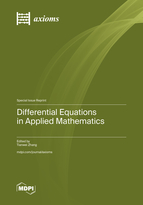Differential Equations in Applied Mathematics
A special issue of Axioms (ISSN 2075-1680). This special issue belongs to the section "Mathematical Analysis".
Deadline for manuscript submissions: closed (31 December 2023) | Viewed by 11147
Special Issue Editor
Interests: stochastic ordinary differential equations; fuzzy ordinary differential equations; fractional ordinary differential equations; functional ordinary; partial differential equations
Special Issues, Collections and Topics in MDPI journals
Special Issue Information
Dear Colleagues,
Numerous significant ideas in applied mathematics have been formulated within the framework of ordinary or partial differential equations, which provides a language for the illustration of these ideas. Through the years, mathematicians and scientists have developed extensions of these methodologies to almost all areas of science and technology.
This Special Issue provides an opportunity to showcase recent developments in the many branches of ordinary or partial differential equations in applied mathematics, which are related to stochastic, fuzzy, functional, and fractional differential or difference equations in sciences and engineering. Among the topics that this Special Issue will address, we will consider the following non-exhaustive list:
- Qualitative analyses of ordinary or partial differential or difference equations;
- Periodic, almost periodic, and almost automorphic oscillations, etc.;
- Random attractors or blowup solutions;
- Lattice dynamic systems;
- Boundary valued problems;
- Neural networks;
- Mathematical models in biology, ecology, economy, etc.;
- Variational methods and other nonlinear analysis techniques;
- Control and optimization, e.g., synchronizations, adaptive controls, automatic control and stochastic optimizations, etc.;
- Numerical analysis on ordinary or partial differential equations;
- Differential equations with discontinuity, e.g., switch systems, Markovian jumping systems;
- Uncertain systems, e.g., stochastic systems, fuzzy systems;
- Discussions of fractional differential or difference equations.
In this Special Issue, we encourage you to submit papers on recent developments in the area of ordinary or partial differential or difference equations in applied areas.
Dr. Tianwei Zhang
Guest Editor
Manuscript Submission Information
Manuscripts should be submitted online at www.mdpi.com by registering and logging in to this website. Once you are registered, click here to go to the submission form. Manuscripts can be submitted until the deadline. All submissions that pass pre-check are peer-reviewed. Accepted papers will be published continuously in the journal (as soon as accepted) and will be listed together on the special issue website. Research articles, review articles as well as short communications are invited. For planned papers, a title and short abstract (about 100 words) can be sent to the Editorial Office for announcement on this website.
Submitted manuscripts should not have been published previously, nor be under consideration for publication elsewhere (except conference proceedings papers). All manuscripts are thoroughly refereed through a single-blind peer-review process. A guide for authors and other relevant information for submission of manuscripts is available on the Instructions for Authors page. Axioms is an international peer-reviewed open access monthly journal published by MDPI.
Please visit the Instructions for Authors page before submitting a manuscript. The Article Processing Charge (APC) for publication in this open access journal is 2400 CHF (Swiss Francs). Submitted papers should be well formatted and use good English. Authors may use MDPI's English editing service prior to publication or during author revisions.
Keywords
- periodic oscillations
- attractor
- lattice
- boundary valued problems
- variational methods
- fixed point theory
- control and optimization
- switch systems
- markovian jump
- discontinuous system
- uncertain system
- stochastic system
- fuzzy





